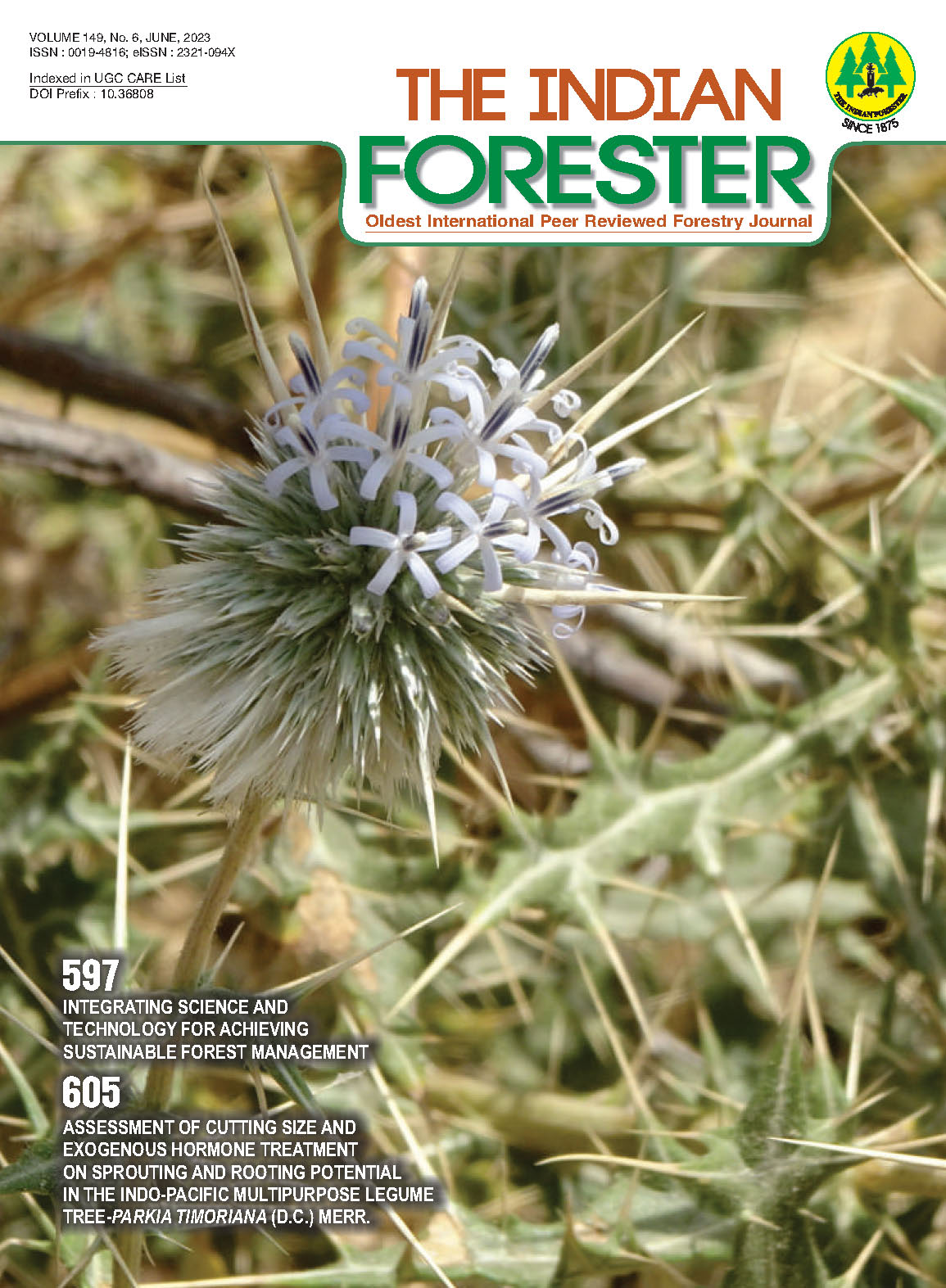Wild Edible Plant Diversity in Alpine Region of Himachal Pradesh
DOI:
https://doi.org/10.36808/if/2023/v149i6/168074Keywords:
Density, Population Status, Edible, Non-Edible, Tribal.Abstract
Study assessed the diversity of wild edible species in the alpine region of Kinnaur district, Himachal Pradesh, following the quadrat method and using random sampling. In total, sixty two plant species were recorded from the study area, Out of which shrubs and herb species were twelve and fifty, respectively. Among these, 29.03% of plant species were edible, and 70.97% were non-edible. Two were shrubs among the edible plants, and the remaining 16 were herbs. The density of edible shrubs Rosa webbiana (0.10 bushes/9m2) and Rhododendron campanulatum (0.08 bushes/9m2) was less as compared to non-edible species like Astragalus candolleanus (0.36 bushes/9m2) and Berberis jaeschkeana (0.31bushes/9m2). Syringa emodi, a non-edible shrub, was the dominant shrub species with an IVI value of 53.53. The total density of wild edible herbs was (2.60 individuals/m2)lower than the density of non-edible herb species (14.56 individuals/m2). Bistorta affinis, a rarely used herb had the highest density of 0.57 individuals/m2, frequency (12.21 %) and IVI (6.65) among edible herbs. Allium wallichii and Eremurus himiliacus were the most preferred edible species recorded from the study area. The people mainly visit the alpine region during the summer months with their domestic animals. As a result, knowledge of wild edible plant species is diminishing, especially among the younger generation. Therefore, public awareness and community-based management need to be encouraged to conserve plant species at all levels.
References
Anon.. (1954). A note on Kinnars, Man in India, 34: 40.
Arora, R.K. and Pandey, A. (1996). Wild edible plants of India: Diversity, conservation and uses. Indian Council of Agricultural Research, National Bureau of Plant Genetic Resources, New Delhi.
Balokhra, J.M. (1998). The wonderland Himachal Pradesh. H.G. Publication, New Delhi, 768 pp.
Bhalla, S. and Bhalla, T.C. (2004). Traditional food and beverages of Himachal Pradesh, Indian Journal of Traditional Knowledge, 6: 17-24.
Brijlal, B., Vats, S.K., Singh, R.D. and Gupta, A.K. (1996). Plants used as ethnomedicine and supplementary food by Gaddis of Himachal Pradesh, India. In: Ethnobotany in human welfare ( K, Jain ed), Deep Publications, New Delhi, India. pp.383-387.
Champers, R.C., Saxena, N.C. and Shah, T. (1989). To the hands of the poor: water and trees. Westview Press, Boulder, Co.
Criddle, R.S., Church, J.N., Smith B.N. and Hansen L.D. (2003). Fundamental causes of the global patterns of species range and richness, Russ. J. Plant Physiol. 50: 192-199.
Curtis, J.T. and McIntosh, R.P. (1950). Inter-relation of certain analytic and synthetic phytosociological characters, Ecology, 31: 434-455.
Dutt, B., Man, V., Hanief, S.M., Thakur, S.D. and Bhardwaj, P.K. (2007). Phytosociological studies of medicinal and aromatic plants of selected sites of Sangla valley in Himachal Pradesh. Journal of Ecology and Conservation, 13(3): 487-491.
Eriksson, O. (1996). Regional dynamics of plants: Review of evidence for remnant, source-sink and meta-populations, Oikos, 77: 248-258.
Gautam, A., Bhatia, K., Mahendra, K. and Bhadauria, R. (2011). Diversity and usage custom of plants of south western of Himachal Pradesh, India- part-I, Journal of Phytology, 3(2): 24-36.
Jain, S.P. and Puri, H.S. (1994). An ethnobotanical survey of Parbati valley in Himachal Pradesh (India), Journal of Economic and Taxonomic Botany, 18 (2): 321-327.
Meenakshi. (2006). Documentation of medicinal and aromatic plants of Kinnaur Forest Division, Himachal Pradesh. Ph.D. Thesis, Department of Forest Products, Dr. Y.S. Parmar University of Horticulture and Forestry, Nauni, Solan (HP), India: 212 pp.
Phillips, E.A. (1959). Methods of Vegetation Study. Henry Holt & Company, New York.
Samant, S.S. and Dhar, U. (1997). Diversity, endemism and economic potential of wild edible plants of Indian Himalaya, International Journal of Sustainable Development & World Ecology, 4(3): 179 -191.
Sharma, P. and Mishra, N.K. (2009). Diversity, utilization pattern and indigenous uses of plants in and around a cement factory in Bilaspur District of Himachal Pradesh, North-western Himalaya, Biological Forum, 1(2): 78-80.
Sharma, P. (2004). Floristic dynamic and distribution pattern of woody plants in Kinnaur, Himachal Pradesh. Ph.D. Thesis, Department of Tree Improvement, College of Forestry, Dr. Y.S. Parmar, University of Horticulture and Forestry, Nauni, Solan (HP).
Sharma, S., Gautam, A.K. and Bhadauria, R. (2009). Some important supplementary food plants and wild edible fungi of upper hilly region of district Shimla (Himachal Pradesh), India, Ethnobotanical Leaflets, 13:1020-28.
Singh, H.B. and Arora, R.K. (1978). Wild edible plants of India (1st ed.). ICAR Publication, New Delhi.
Singh, J., Rajasekaran, A., Negi A.K. Panwar, V.P. ( 2016). Wild edible plant diversity in Pinus gerardiana Wall. ex D. Don. forests of Kinnaur district, Himachal Pradesh, India, Indian Journal of Forestry, 39(1): 13-20.
Singh, J., Rajasekaran, A. and Sharma, K.D. (2008). Traditional ethnobotanical knowledge of Kiran Pargana, Shimla District, Himachal Pradesh, Journal of Economic and Taxonomic Botany, 32:253-263.
Verma, R. K. and Kapoor, K.S. (2010). Phyto-sociological studies in Hitch valley of Rakchham Chitkul wildlife sanctuary of District Kinnaur, Himachal Pradesh, Biological Forum- An International Journal, 2(2):94-104.
Verma, R.K., Kapoor, K.S., Subramani, S.P. and Jishtu, V. (2003). Assessment of plant species diversity in Betula utilis D.Don forest in cold arid region of Himachal Pradesh, Environ. Ecol., 21(4): 922-927.
Woodward, F.I. (1988). Temperature and the distribution of plant species and vegetation. In: Plants and Temperature (S.P. Long and F.I. Woodward Eds.), Society of Experimental Biology by the Company of Biologists Limited, Cambridge, pp. 59-75.
Zobel, M. (1997). The relative role of species pools in determining plants species richness: an alternative explanation of species coexistence, Trend in Ecology and Evolution, 12: 266-269.
Downloads
Downloads
Additional Files
Published
How to Cite
Issue
Section
License
Unless otherwise stated, copyright or similar rights in all materials presented on the site, including graphical images, are owned by Indian Forester.





